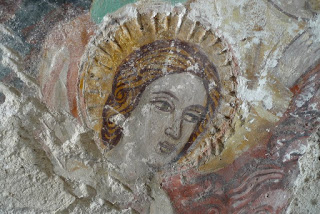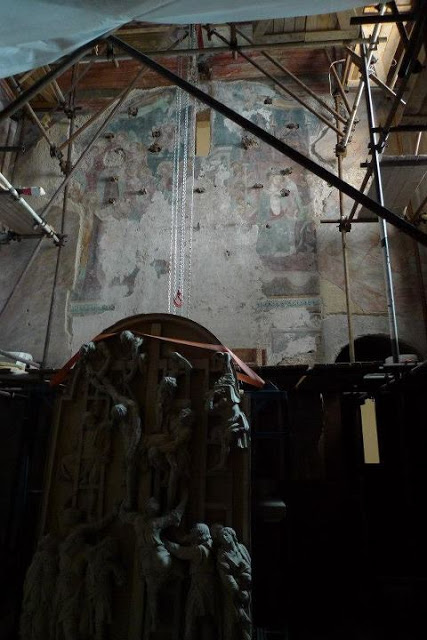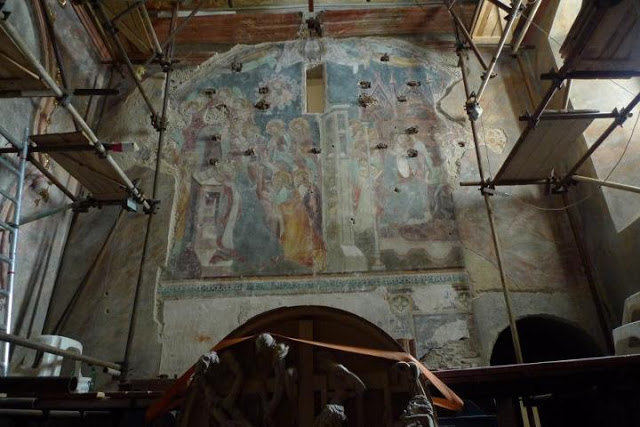Medieval History
 The cathedral of Nyitra (Nitra, Slovakia) is one of the oldest, most complex, and - until quite recently - least known cathedral building of medieval Hungary. Located north-east of Pozsony/Pressburg/Bratislava, the bishopric of Nyitra was founded before the Magyar Conquest, at 880. The bishopric was established at the seat of the Principality of Nyitra, on the eastern fringes of the Carolingian Empire. After the Conquest, the settlement became a ducal residence, and king Koloman I reestablished the bishopric some time before 1113. The cathedral was dedicated to St. Emmeram, as well as to the canonized local hermits, St. Zoerard and Benedict. The cathedral has a dual church: one dating from the Romanesque period, while the other Gothic, from the middle of the 14th century. However, the entire ensemble was rebuilt in Baroque style. The restoration and research of the buildings have been going on since 2007. Already, this research has yielded spectacular results: especially with the uncovering of a large Renaissance red marble tabernacle (with a frame of white marl from Buda), similar to the ones known from the parish church of Pest and from the cathedral of Pécs. Dated 1497, the Renaissance tabernacle at Nyitra is earlier than these, being a very significant example of Florentine-style early Renaissance carving in Hungary.
The cathedral of Nyitra (Nitra, Slovakia) is one of the oldest, most complex, and - until quite recently - least known cathedral building of medieval Hungary. Located north-east of Pozsony/Pressburg/Bratislava, the bishopric of Nyitra was founded before the Magyar Conquest, at 880. The bishopric was established at the seat of the Principality of Nyitra, on the eastern fringes of the Carolingian Empire. After the Conquest, the settlement became a ducal residence, and king Koloman I reestablished the bishopric some time before 1113. The cathedral was dedicated to St. Emmeram, as well as to the canonized local hermits, St. Zoerard and Benedict. The cathedral has a dual church: one dating from the Romanesque period, while the other Gothic, from the middle of the 14th century. However, the entire ensemble was rebuilt in Baroque style. The restoration and research of the buildings have been going on since 2007. Already, this research has yielded spectacular results: especially with the uncovering of a large Renaissance red marble tabernacle (with a frame of white marl from Buda), similar to the ones known from the parish church of Pest and from the cathedral of Pécs. Dated 1497, the Renaissance tabernacle at Nyitra is earlier than these, being a very significant example of Florentine-style early Renaissance carving in Hungary.
As fellow blogger Gábor Endr?di (1100sor) reported yesterday, the central relief of the Baroque altarpiece was removed last weekend, and the full fresco soon sprang to sight. Led by restorer Vladimir Plekanec, the surface of the wall painting will be cleaned. It is not yet clear how to proceed once the restoration of both the fresco and the altarpiece is complete.
- 14th Century Church Fresco Uncovered In Budapest
A Hungarian priest, Zoltán Osztie, and archaeologist Imre Bodor presented a rediscovered medieval fresco to the media on Thursday. The fresco, which portrays the infant Jesus and the Virgin Mary, was uncovered on a sanctum wall behind the main altar...
- 800 Years Of Ják Abbey
Fresco of St. George at Ják, c. 1256 This weekend - the weekend after Saint George's Day - mark the 800th anniversary of the foundation of the Benedictine monastery of Ják. It is known that the monastery was established by Márton "the Great"...
- First Publications On The Murals Of The Parish Church Of Pest
The 14th century fresco of the Virgin of Child, discovered last year in the sanctuary of the Inner City Parish Church of Pest (in downtown Budapest) created quite a stir. I suppose it always creates some stir when a a fresco appears older than the wall...
- The Medieval Parish Church Of Pest (part Ii.) - A Remarkable Discovery
This post focuses on the medieval fresco decoration of the Inner City parish church of Pest - you can read my introduction to the history of the building here. Not much survived of the original painted decoration of the Inner City parish church....
- The Medieval Parish Church Of Pest (part I.)
The Inner City parish church is perhaps the most frequently-seen, yet most overlooked major medieval building in Budapest. Standing in the middle of the city, right next to Elizabeth bridge, modern-day citizens of Budapest zoom by it every day. The church,...
Medieval History
Late 14th century frescoes discovered at Nitra cathedral
 The cathedral of Nyitra (Nitra, Slovakia) is one of the oldest, most complex, and - until quite recently - least known cathedral building of medieval Hungary. Located north-east of Pozsony/Pressburg/Bratislava, the bishopric of Nyitra was founded before the Magyar Conquest, at 880. The bishopric was established at the seat of the Principality of Nyitra, on the eastern fringes of the Carolingian Empire. After the Conquest, the settlement became a ducal residence, and king Koloman I reestablished the bishopric some time before 1113. The cathedral was dedicated to St. Emmeram, as well as to the canonized local hermits, St. Zoerard and Benedict. The cathedral has a dual church: one dating from the Romanesque period, while the other Gothic, from the middle of the 14th century. However, the entire ensemble was rebuilt in Baroque style. The restoration and research of the buildings have been going on since 2007. Already, this research has yielded spectacular results: especially with the uncovering of a large Renaissance red marble tabernacle (with a frame of white marl from Buda), similar to the ones known from the parish church of Pest and from the cathedral of Pécs. Dated 1497, the Renaissance tabernacle at Nyitra is earlier than these, being a very significant example of Florentine-style early Renaissance carving in Hungary.
The cathedral of Nyitra (Nitra, Slovakia) is one of the oldest, most complex, and - until quite recently - least known cathedral building of medieval Hungary. Located north-east of Pozsony/Pressburg/Bratislava, the bishopric of Nyitra was founded before the Magyar Conquest, at 880. The bishopric was established at the seat of the Principality of Nyitra, on the eastern fringes of the Carolingian Empire. After the Conquest, the settlement became a ducal residence, and king Koloman I reestablished the bishopric some time before 1113. The cathedral was dedicated to St. Emmeram, as well as to the canonized local hermits, St. Zoerard and Benedict. The cathedral has a dual church: one dating from the Romanesque period, while the other Gothic, from the middle of the 14th century. However, the entire ensemble was rebuilt in Baroque style. The restoration and research of the buildings have been going on since 2007. Already, this research has yielded spectacular results: especially with the uncovering of a large Renaissance red marble tabernacle (with a frame of white marl from Buda), similar to the ones known from the parish church of Pest and from the cathedral of Pécs. Dated 1497, the Renaissance tabernacle at Nyitra is earlier than these, being a very significant example of Florentine-style early Renaissance carving in Hungary. |
| Tabernacle from 1497 at Nyitra (Photo: Roznava24) |
As restoration of the church continued this summer, work progressed in the southern church building of the cathedral. This is the building with a Romanesque apse, which has been extended/rebuilt towards the west in the 14th century. This construction likely dates to 1378, when such work carried out by bishop Dominic was recorded. Already at the beginninf of the year, parts of a Late Gothic fresco have been spotted behind a Baroque stone altar dating from 1662. Now, however, the entire altarpiece has been temporarily dismantled, and the entire fresco can be seen and studied. The find is of major importance: it comes from a cathedral church, and the centuries behind the altarpiece saved the fresco from any repainting or earlier restorations. The condition of the painted surface is thus fully intact - and this surface is of a considerable size. The quality of the paintings is also very high - along with the recently uncovered frescoes of Torna (Tur?a nad Bodvou, near Ko?ice) they are defitinely among the finest wall paintings from the decades around 1400 from Upper Hungary. The theme of the frescoes is a Marian cycle, with the Last Prayer and the Coronation of the Virgin.
As fellow blogger Gábor Endr?di (1100sor) reported yesterday, the central relief of the Baroque altarpiece was removed last weekend, and the full fresco soon sprang to sight. Led by restorer Vladimir Plekanec, the surface of the wall painting will be cleaned. It is not yet clear how to proceed once the restoration of both the fresco and the altarpiece is complete.
The photos below have been taken from the website of the newspaper sme.sk and from the facebook page of Ján Stupka.
 |
| The chapel with the altarpiece still intact |
 |
| First medieval frescoes discovered behind the altar (Febr. 2012) |
 | ||
Frescoes revealed behind the top part of the altar
|
 | ||
Uncovery of the Coronation of the Virgin
|
- 14th Century Church Fresco Uncovered In Budapest
A Hungarian priest, Zoltán Osztie, and archaeologist Imre Bodor presented a rediscovered medieval fresco to the media on Thursday. The fresco, which portrays the infant Jesus and the Virgin Mary, was uncovered on a sanctum wall behind the main altar...
- 800 Years Of Ják Abbey
Fresco of St. George at Ják, c. 1256 This weekend - the weekend after Saint George's Day - mark the 800th anniversary of the foundation of the Benedictine monastery of Ják. It is known that the monastery was established by Márton "the Great"...
- First Publications On The Murals Of The Parish Church Of Pest
The 14th century fresco of the Virgin of Child, discovered last year in the sanctuary of the Inner City Parish Church of Pest (in downtown Budapest) created quite a stir. I suppose it always creates some stir when a a fresco appears older than the wall...
- The Medieval Parish Church Of Pest (part Ii.) - A Remarkable Discovery
This post focuses on the medieval fresco decoration of the Inner City parish church of Pest - you can read my introduction to the history of the building here. Not much survived of the original painted decoration of the Inner City parish church....
- The Medieval Parish Church Of Pest (part I.)
The Inner City parish church is perhaps the most frequently-seen, yet most overlooked major medieval building in Budapest. Standing in the middle of the city, right next to Elizabeth bridge, modern-day citizens of Budapest zoom by it every day. The church,...



